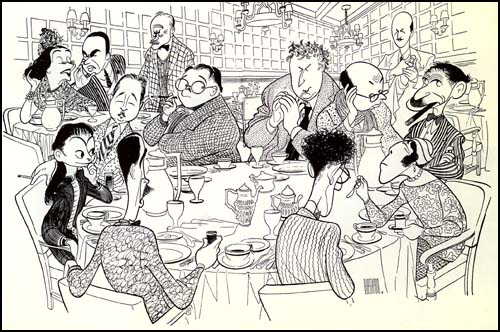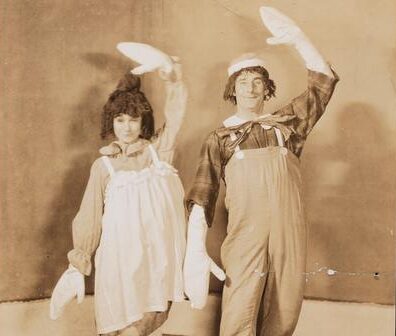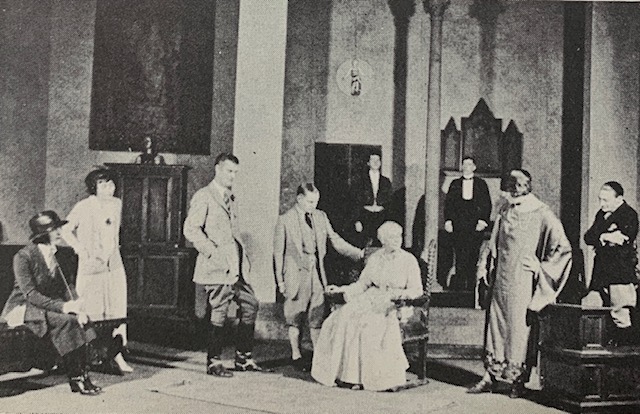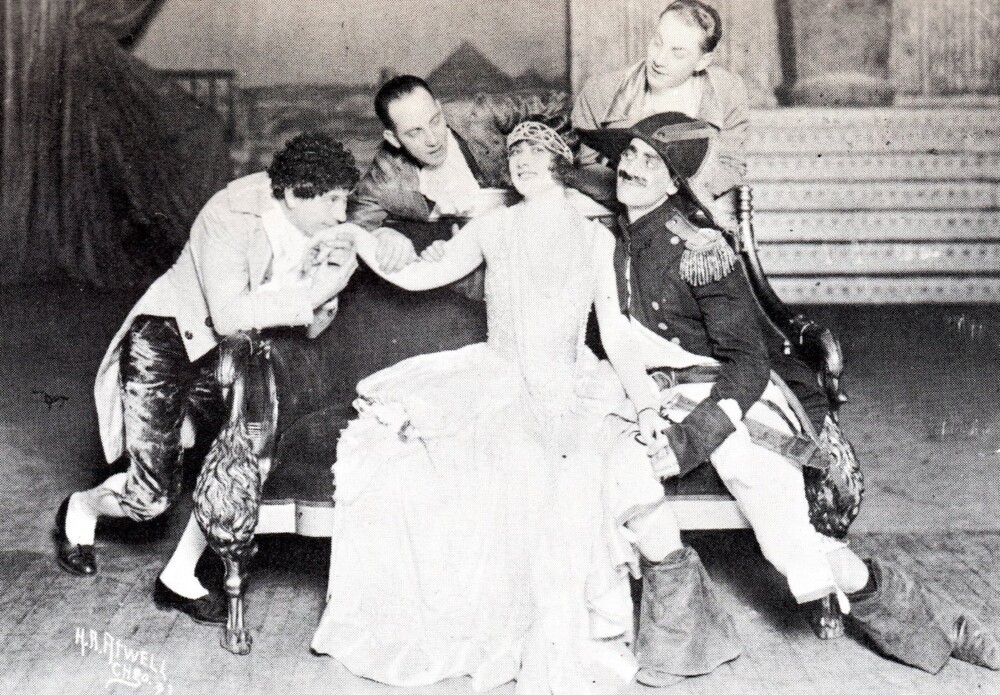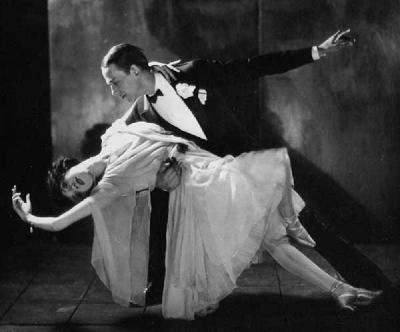
Fred and Adele Astaire, 1921 – The Love Letter
By Samuel L. Leiter
Today we look back on four musicals of 1921-1922, a season, like those immediately before and after, not known for the glory of its musical theater. Naturally, as the shows surveyed here reveal, it was easy enough to find entertainment, but very little was significant in the longer scheme of things. Great musical comedy was in remission while revues—both intimate and spectacular—were pulling in the crowds.
Actually, it can sometimes be tough to decide if a show was a musical or a revue; several of the latter had slender plots that made them borderline book shows. Two examples from 1921-1922 are Bombo and The Perfect Fool, the former a vehicle for Al Jolson, the latter for Ed Wynn. Placing them with the revues leaves seventeen musical comedies for the season, from which I’ve chosen Tangerine, Blossom Time, The Love Letter, and Good Morning, Dearie. There are no Show Boats among them, but a few of their songs are still rolling along.


Frank Crumit and Julia Sanderson in Tangerine
Tangerine, despite opening in midsummer (Casino Theatre, August 9, 337), was juicy enough to last all season. Its book, by Philip Bartholomae and Guy Bolton, was tangier than others of its crop, and it had plenty of fresh-squeezed humor. One of its two standout songs, “Sweet Lady,” was an interpolation (common back then) by David Zoob and Frank Crumit, one of the stars. The other, “Listen to Me,” was from the original score: music by Monte Carlo and Alma Sanders; lyrics by Howard Johnson.
Some were surprised by the continuity of the amusing plot at a time when well-structured musicals were rare. The story followed the adventures of three men: Jack Floyd (Harry Puck), Lee Loring (Allen Kearns); and Fred Allen (Joseph Herbert, Jr.). On getting out of jail for nonpayment of alimony they head for the South Seas paradise of Tangerine.
They’ve gotten the idea from another cellmate, their buddy Dick Owens (Crumit), whose girlfriend, Shirley Dalton (Julia Sanderson), has been giving him a hard time. Tangerine is ruled by King Home-Brew (John E. Hazzard), an expat American whose many wives compose the grass-skirted chorus line. In his chauvinistic kingdom, the women slave away while the men loll at their ease. At Owen’s bidding, the ex-cons’ estranged-wives arrive and, before long, the marriages are fixed and Owens and Shirley reunite. The king, though, winds up entirely spouseless.
Arthur Hornblow decided, “It is well but not extravagantly staged and mounted and it has a well-rounded cast with no superfluous people even in the chorus.”


Bertram Peacock, Olga Cook, Colin O’Moore in Blossom Time


Not long after came the season’s musical theater champion, Blossom Time (Ambassador Theatre, September 29, 516), which kept blooming into 1923. It was an adaptation by Dorothy Donnelly (book/lyrics) of a Viennese operetta with a solid track record, under different titles (Lilac Time in London), in various European capitals. (A New York stock company had staged it briefly, in German, in 1918.) The score was by famed Austrian composer Franz Schubert but, to satisfy American tastes, the script was radically adapted by Donnelly and the orchestrations by leading composer Sigmund Romberg.
Blossom Time was a semifictionalized biographical account of Schubert’s (Bertram Cook) life, concentrating on a tragic love affair leading to his early death. The premise held that the music—by now familiar to the world at large—was being performed at those big moments when Schubert was inspired to write it.
On the one hand, the critics turned up their noses at the popularization of the original melodies. On the other, they huzzaed the producers for bringing classical music to the Great White Way and thereby to the ragtime-jaded ears of American youth, who, it was hoped, would soon be playing it at their college parties and on their gramophones.
“Serenade,” “Ave Maria,” “Song of Love” (from Schubert’s The Unfinished Symphony) and “The Military March” were highlights. Olga Cook as Schubert’s lover, Mitzi, Howard March as Schober, and Bertram Peacock as the composing genius sang with feeling and skill. Blossom Time was fragrant enough to enjoy six additional New York productions through 1943, although these grew progressively tacky.
Another European-inspired operetta was The Love Letter (Globe Theatre, October 4, 31), adapted by William Le Baron from Hungarian playwright Ferenc Molnar’s The Phantom Rival (produced in 1914 by David Belasco), with music by Victor Jacob. Unfortunately, it died when only a month old despite all the earmarks of a hit. This may have led to the fatal heart attack of its despondent, 37-year-old composer several weeks afterward.
The Love Letter was provided by producer Charles Dillingham with gorgeous costumes and sets, the latter by the admirable Joseph Urban, who provided an exquisite maroon ballroom for a dream scene. These visuals adorned a work in which Miriam (Carolyn Thompson), unhappy with the choice of a decidedly plain husband made for her by her mother (Katherine Stewart), fantasizes about Philip (John Charles Thomas), her true love. He had written her a love letter when he went off several years earlier, promising to return—in what guise he could only guess. Miriam dreams of him arriving in various romantic roles, but when he finally shows up for real, it’s as a successful businessman (in Molnar, it’s as a dull hick). Still, the lovers live happily ever after.
“[S]heer melody, beautiful voices and romantic plot,” combined with “many gifted players,” pleased Arthur Hornblow, raising The Love Letter, whose best song was “My Heart Beats for You,” well above its competitors. A chief component of its appeal was the existence in supporting roles of siblings Fred and Adele Astaire, budding superstars who stole the show with their “Upside Down” dance routine. (The Astaires would sparkle again this season in For Goodness Sake.)
Fred, in Steps in Time, tells of how choreographer Edward Royce developed “Upside Down.” Royce first had Adele circle the stage as if she were riding a bike as the band kept going “um-pah, um-pah.” He then had Fred join her, shoulder to shoulder. He took a five-minute break and, when he returned, said, “What we need here . . . is a ‘nut’ number. It should make no sense at all in lyrics and then the dance should be silly and tricky until you both drop into this run-around thing and then eventually you just run offstage. I think it’ll bring down the house.” Royce then instructed the composer and lyricist to write a song to fit the number. Astaire continues: “That run-around finish became a trademark of ours and we used it in five different shows over a period of about ten years.”


Jerome Kern remains near the apex of Broadway composers whose songs became standards. Such was the case with a couple of his contributions to Good Morning, Dearie (Globe Theatre, November 1, 347). This show had an innocuous title and a conventional rags-to-riches Cinderella story, but its musical excellences were so conspicuous that Kenneth Andrews called it “the best musical comedy of the year.”
The storyline followed pretty young shop girl Rose-Marie (Louise Groody), loved by millionaire Billy Van Cortland (Oscar Shaw), but also possessed of a bothersome ex-con boyfriend, Chesty (Harland Dixon). The plotting involves the two rivals in a Chinatown dance hall brawl and later has Chesty attempting to steal the family jewels from Billy’s wealthy sister (Roberta Beatty) during a fete at her fancy home. Rose-Marie appears in disguise to foil the crook and end up in Billy’s wealthy arms.
The tuneful show, from which the Hawaiian melody “Ka-lu-a” became a standard, also included “Blue Danube Blues” and “Every Girl.” The best-known tune was “Look for the Silver Lining,” a Kern hit from Sally interpolated for good measure. During the run, Kern was sued by another songwriter who claimed that “Ka-lu-a” had been stolen from him. Kern wound up paying $250 to end the suit.
Waiting in the wings: the best revues of 1921-1922.



